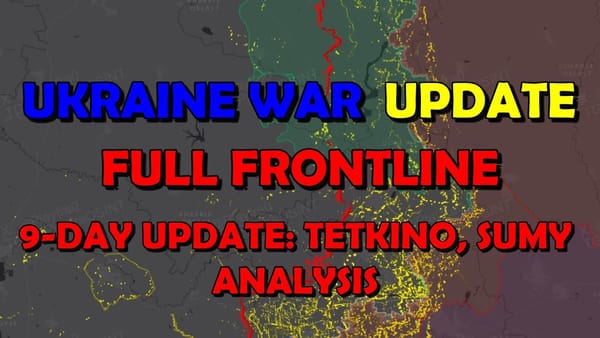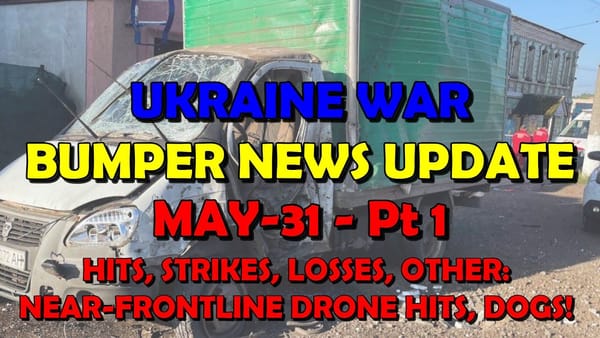Ukraine Conflict: 4-Day Full Frontline Update
Table of Contents 📖
"They [Russia] are not interested in liberating, they’re not interested in the people of Ukraine, they’re interested in what Ukraine can get them, they’re just they just have imperialistic intentions."
Hello Team
🎦 00:01-00:50⏩
Jonathan welcomes viewers to a new frontline update, covering the past four days due to a gap since the last update. He acknowledges the map will be slightly outdated due to ongoing developments.
Return to top⤴️
📍 FRONT-LINE UPDATE -🗺️ MAP LEGEND

Mapping Methodology and Corrections for the Kursk Region
🎦 00:50-08:19⏩
Jonathan explains his mapping methodology, clarifying that blue and red lines usually represent Russian defensive lines from different sources. He admits an error in the Kursk region, where he incorrectly mapped the Ukrainian defensive line. He apologises for the mistake and emphasizes that the blue line in that area represents Ukrainian control according to Andrew Perpetua, while the red line signifies Russian control according to Suriyak Maps. He highlights discrepancies between the two mappers, showcasing the fluidity of the situation.
Return to top⤴️
Kursk Oblast: Ukrainian Gains and Russian Counterattacks
🎦 08:19-14:30⏩
- Jonathan analyses Russian advancements over the past year, noting their limited progress despite military capabilities, citing sources like the Institute for the Study of War (ISW).
- He emphasizes the distinction between tactical and operational gains, arguing that while Russia has made some tactical gains, they haven't achieved operationally significant victories.
- He references Radu Hosu's analysis, highlighting missed deadlines set by Putin for retaking Ukrainian territory.
- The fall of Vovchansk after a long resistance is discussed.
- Jonathan shows footage of destroyed equipment in Kursk, noting significant losses on both sides, with Ukraine suffering more equipment losses.
- He examines the situation in Ovchansk, reporting Ukrainian pushback but heavy Russian bombardment.
Kharkiv Oblast: Minimal Changes and Analysis of Russian Offensive
🎦 14:30-27:36⏩
- Jonathan reports minimal changes in the Kharkiv sectors.
- He analyses the Sienkiewka-Kupiansk area, noting no confirmed changes despite claims from some mappers.
- He revisits the area of a successful Russian attack near Nowa Vodzianie, observing the slowed momentum of the Russian advance towards the Oskil River.
- The relatively static frontline around the Serebiansky Forest is discussed, with slight changes noted from Suriyak Maps near the Verkhn’okam’yans’ke area.
- The stalled Russian offensive towards Chesifiar is analyzed, highlighting the missed objective of capturing it by the end of summer.
- Jonathan speculates on factors contributing to the slowed Russian advance, including potential troop redeployments to defend against Ukrainian counteroffensives in Kursk and the ongoing attrition of Russian forces.
- He examines the situation in Turetsk, noting the differing assessments from Andrew Perpetua and Suriyak Maps, and highlighting the significant destruction in the city.
- He observes the Russian advance near Shebunivka along the railway line.
- The Prokhorivka frontline is discussed, with Jonathan pointing out the slowed Russian progress and the significance of Ukrainian defensive trenches.
- He acknowledges the strategic importance of railway lines for logistics and supply.
- The capture of Vuhledar is analyzed, with Jonathan emphasizing its extrinsic value in terms of HIMARS range and artillery positioning, rather than its intrinsic worth as a heavily destroyed city.
- The significance of losing Karakova and the potential shift of Ukrainian supply hubs further back are also considered.
- Despite acknowledging Ukrainian losses, Jonathan reiterates his belief that Russian attrition remains a significant factor, potentially hindering their ability to achieve maximalist goals.
Zelensky's Comments on Vuhledar and the Realities of Warfare
🎦 27:36-31:05⏩
- Jonathan highlights Zelensky’s comments on the withdrawal from Vuhledar, where he defends the decision, stating “lives are more important than buildings”.
- Jonathan acknowledges criticisms aimed at Zelensky regarding the timing of the withdrawal, with some arguing for a quicker exit to minimize casualties.
- He reflects on the challenges of making strategic decisions during war, acknowledging the limitations of offering opinions without being on the ground with complete information.
- Jonathan compares the situation to the Second World War, pointing out that even the allies made bad decisions, and war is inherently complex and chaotic.
Wrap Up
🎦 31:05-31:28⏩
- Jonathan concludes by expressing hope that the video was informative.
- He encourages viewers to like, subscribe, and share the video.
- He thanks viewers for their support and acknowledges his mapping errors, attributing it to the vast amount of information he processes daily. He signs off with a lighthearted remark about making mistakes.



